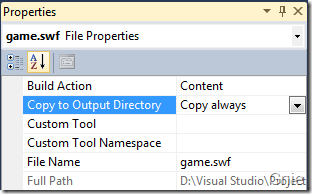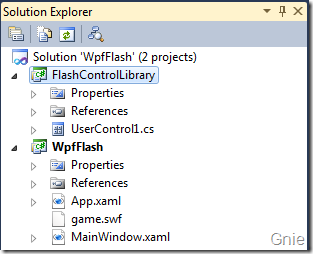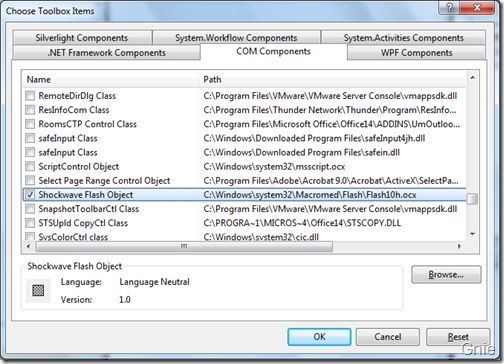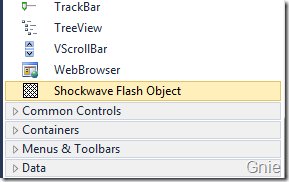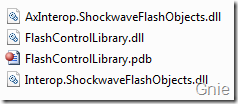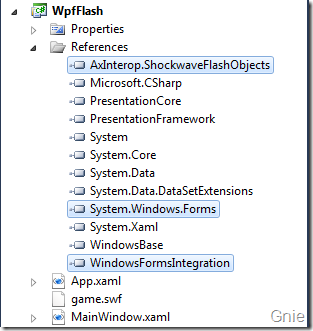方案一:用WebBrowser实现
要想实现Flash的播放支持,需要借助Flash自身的ActiveX控件.
而WPF作为一种展现层的技术,不能自身插入COM组件,必需借助Windows Form引入ActiveX控件.
比较标准的实现方法,可以参考以下链接:http://blogs.msdn.com/b/jijia/archive/2007/06/07/wpf-flash-activex.aspx
而本文则是介绍通过借助System.Windows.Forms下的WebBrowser实现.
但无论是那一种方法,本质上都是通过在WPF程序中引用Windows Form窗体,再在其内引入ActiveX控件.
实现对Flash的播放
首先,引入可在WPF上承载 Windows 窗体控件的元素:WindowsFormsHost,及添加对 Windows 窗体的引用.
具体的实现过程:项目引用--添加引用--程序集中选择 "WindowsFormsIntegration" 及 "System.Windows.Forms" --添加
在WPF页面分别添加这两者的引用:
xmlns:host="clr-namespace:System.Windows.Forms.Integration;assembly=WindowsFormsIntegration"
xmlns:forms="clr-namespace:System.Windows.Forms;assembly=System.Windows.Forms"
XAML中的所有实现代码:
xmlns="http://schemas.microsoft.com/winfx/2006/xaml/presentation" xmlns:x="http://schemas.microsoft.com/winfx/2006/xaml" xmlns:host="clr-namespace:System.Windows.Forms.Integration;assembly=WindowsFormsIntegration" xmlns:forms="clr-namespace:System.Windows.Forms;assembly=System.Windows.Forms" Title="File Capture" Height="600" Width="800" Unloaded="Window_Unloaded" >
当需要把一选中的Flash文件(.swf 文件)添加进WebBrowser 中播放:browser.Navigate(currentPath);
实现对Flash的截图
实现对Flash的截图,只要使用WebBrowser的基类WebBrowserBase里面的DrawToBitmap方法.
参数Bitmap为所绘制的位图(需初始化位图的大小),Rectangle为截取WebBrowser内容的区域(大小)
public voidDrawToBitmap(
Bitmap bitmap,
Rectangle targetBounds
)
具体的实现代码:
private void Capture()
{
string fileName = System.IO.Path.GetFileNameWithoutExtension(currentPath);
string capturePath = string.Format("{0}\\Capture\\{1}", System.Environment.CurrentDirectory, fileName);
if (!Directory.Exists(capturePath))
{
Directory.CreateDirectory(capturePath);
}
Bitmap myBitmap = new Bitmap((int)host.ActualWidth, (int)host.ActualHeight);
System.Drawing.Rectangle DrawRect = new System.Drawing.Rectangle(0, 0, (int)host.ActualWidth, (int)host.ActualHeight);
browser.DrawToBitmap(myBitmap, DrawRect);
string timeNow = DateTime.Now.ToString("yyyyMMddHHmmssfff");
myBitmap.Save(string.Format("{0}\\{1}_{2}.png", capturePath, fileName, timeNow));
}
本实例实现了对Flash的循环截图,时间间隔为1秒.本部分比较简单,
通过使用System.Windows.Threading下的DispatcherTimer即可实现.
using System;
using System.Collections.Generic;
using System.Linq;
using System.Text;
using System.Windows;
using System.Windows.Controls;
using System.Windows.Data;
using System.Windows.Documents;
using System.Windows.Input;
using System.Windows.Media;
using System.Windows.Media.Imaging;
using System.Windows.Navigation;
using System.Windows.Shapes;
using Microsoft.Win32;
using System.Drawing;
using System.IO;
using System.Windows.Threading;
namespace Capture
{
///
/// MainWindow.xaml 的交互逻辑
///
public partial class MainWindow : Window
{
private string currentPath;
private DispatcherTimer captureTimer;
public MainWindow()
{
InitializeComponent();
}
private void btnOpen_Click(object sender, RoutedEventArgs e)
{
currentPath = OpenUserFileDialog();
if (!string.IsNullOrEmpty(currentPath))
LoadedFile();
}
private void btnCapture_Click(object sender, RoutedEventArgs e)
{
if ((bool)cboxLoop.IsChecked)
RunTimer();
else
Capture();
}
private void btnStop_Click(object sender, RoutedEventArgs e)
{
if (captureTimer != null && captureTimer.IsEnabled)
captureTimer.Stop();
}
private string OpenUserFileDialog()
{
string pathFile = string.Empty;
OpenFileDialog openFileDialog = new OpenFileDialog();
openFileDialog.FilterIndex = 1;
openFileDialog.Multiselect = false;
openFileDialog.AddExtension = true;
openFileDialog.ValidateNames = true;
if (openFileDialog.ShowDialog().Equals(true))
pathFile = openFileDialog.FileName;
return pathFile;
}
private void LoadedFile()
{
try
{
browser.Navigate(currentPath);
}
catch { }
}
private void Capture()
{
string fileName = System.IO.Path.GetFileNameWithoutExtension(currentPath);
string capturePath = string.Format("{0}\\Capture\\{1}", System.Environment.CurrentDirectory, fileName);
if (!Directory.Exists(capturePath))
{
Directory.CreateDirectory(capturePath);
}
Bitmap myBitmap = new Bitmap((int)host.ActualWidth, (int)host.ActualHeight);
System.Drawing.Rectangle DrawRect = new System.Drawing.Rectangle(0, 0, (int)host.ActualWidth, (int)host.ActualHeight);
browser.DrawToBitmap(myBitmap, DrawRect);
string timeNow = DateTime.Now.ToString("yyyyMMddHHmmssfff");
myBitmap.Save(string.Format("{0}\\{1}_{2}.png", capturePath, fileName, timeNow));
}
private void RunTimer()
{
if (captureTimer == null)
captureTimer = new DispatcherTimer();
captureTimer.Interval = TimeSpan.FromMilliseconds(1000);
captureTimer.Tick += captureTimer_Tick;
if (!captureTimer.IsEnabled)
captureTimer.Start();
}
private void captureTimer_Tick(object sender, EventArgs e)
{
Capture();
}
private void Window_Unloaded(object sender, RoutedEventArgs e)
{
try
{
browser.Dispose();
}
catch { }
}
}
}
方案二:将Flash 嵌入WPF 程序
https://www.cnblogs.com/gnielee/archive/2010/07/27/wpf-flash-activex.html
https://blog.csdn.net/xingxing513234072/article/details/8919596
http://blog.sina.com.cn/s/blog_952cdb2a0100xl1f.html
由于WPF 本身中不支持COM 组件同时也无法加载ActiveX 控件,所以需要借助WinForm 引用ActiveX 控件将Flash 加入其中。首先创建一个WPF 项目(WpfFlash),将Flash 文件(.swf)加入到项目中,并将Copy to Output Directory 设置为"Copy always"。
在工程中新增一个Windows Forms Control Library 项目(FlashControlLibrary),利用该控件库加载Flash ActiveX。
在FlashControlLibrary 项目工具栏(Toolbox)中点击鼠标右键,选择"Choose Items..."。在COM Components 标签中选择"Shockwave Flash Object",点击确定。
此时在工具栏中已经可以看到刚添加的Shockwave Flash Object 控件了。将控件拖入设计窗口,调整好控件尺寸使其满足Flash 的尺寸大小,对FlashControlLibrary 项目进行编译,并生成DLL 文件。
返回WpfFlash 项目将上面编译的AxInterop.ShockwaveFlashObjects.dll 加入References,并添加System.Windows.Forms 和WindowsFormsIntegration,便于WinForm 程序在WPF 中交互使用。
接下来将通过两种方式将Flash 文件加入到WPF,一种侧重于使用XAML 代码实现,另一种则使用C#。可按各自需要选择其一。
XAML 方法
打开MainWindow.xaml,加入命名空间xmlns:f="clr-namespace:AxShockwaveFlashObjects;assembly=AxInterop.ShockwaveFlashObjects"。在
xmlns="http://schemas.microsoft.com/winfx/2006/xaml/presentation" xmlns:x="http://schemas.microsoft.com/winfx/2006/xaml" xmlns:f="clr-namespace:AxShockwaveFlashObjects;assembly=AxInterop.ShockwaveFlashObjects" Title="Crab Shooter" Height="540" Width="655">
打开MainWindow.xaml.cs 将Flash 文件加载到flashShow 控件。
using System;using System.Windows;namespace WpfFlash{ public partial class MainWindow :Window
{public MainWindow() { InitializeComponent();string flashPath =Environment.CurrentDirectory; flashPath +=@"\game.swf"; flashShow.Movie = flashPath; } }}
C# 方法
使用C# 实现相同的效果,首先将XAML 代码按如下方式修改,在Window 中加入Loaded 事件。
xmlns="http://schemas.microsoft.com/winfx/2006/xaml/presentation" xmlns:x="http://schemas.microsoft.com/winfx/2006/xaml" Title="Crab Shooter" Loaded="FlashLoaded" Height="540" Width="655">
定义FlashLoaded 方法,主要通过WindowsFormsHost和 AxShockwaveFlash 完成Flash 加载操作。
using System;using System.Windows;using System.Windows.Forms.Integration;using AxShockwaveFlashObjects;namespace WpfFlash{public partial class MainWindow :Window
{public MainWindow() { InitializeComponent(); }private void FlashLoaded(object sender,RoutedEventArgs e) {WindowsFormsHost formHost =new WindowsFormsHost();AxShockwaveFlash axShockwaveFlash =new AxShockwaveFlash(); formHost.Child = axShockwaveFlash; mainGrid.Children.Add(formHost);string flashPath =Environment.CurrentDirectory; flashPath +=@"\game.swf"; axShockwaveFlash.Movie = flashPath; } }}
效果图
